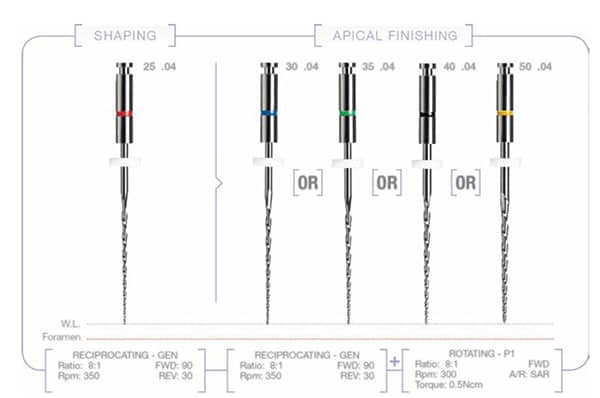Dr. Carlos Spironelli Ramos discusses newly debuted products by Ultradent

Endodontic NiTi instruments feature the shape memory effect and super elasticity of NiTi alloy that make them ideal for the enlargement of curved root canals; and NiTi rotary instruments with varying cross-sectional designs and tapers have been developed and marketed over the past 2 decades. However, despite their clear advantages, NiTi instruments in rotational movement may undergo premature failure from cyclic fatigue, which is the life-limiting factor for these instruments’ clinical use.1
A reciprocating motion decreases the impact of cyclic fatigue on NiTi instrument life compared with rotational motion. In reciprocation, the instrument is subjected to lower tensile and compressive stress, operating for a longer period of time before separation.2
But there is a downside to employing only reciprocation movement — debris removal appears to be less efficient when compared to rotary movement. Furthermore, the internal dentin wall surface looks better under the effect of rotary instruments than when instrumented only with reciprocating movement. It seems reasonable to begin with the safety of reciprocating movement to open the space securely until the apical limit and then to finish with rotation to carry out the debris. Unfortunately, if the clinician chooses to use the two movements for safety and efficiency, it must be performed with two different file systems — starting with reciprocation, changing the file for another system, and then trying to match to the proper rotary file in sequence.
The Genius™ files and EVOS™ motor
Genius files are designed with an S-cross section and constant .04 taper to shape and clean the root canal system while preserving more tooth structure. They are compatible with both reciprocation and rotary movement, and operate ideally in the 90° clockwise and 30° counterclockwise movement provided by the EVOS endodontic motor. This reciprocation movement not only reduces the risk of file fracture due to torsional and cyclic fatigue, but also creates a smooth path to the apical limit. After safely reaching the apical limit, Genius files can then be used in 360° rotation to better remove debris from the canal.
The EVOS endodontic motor also features auto-stop settings that interrupt movement when a set torque limit is reached.
The EVOS endodontic motor and Genius files: designed to put rotary and reciprocation together
Studies show that reciprocating motion reduces cyclic and torsional fatigue, while rotary movement removes debris more efficiently. Utilizing an endodontic system, which allows both reciprocation and rotary movements, minimizes the risk of complications. The new EVOS endodontic motor with the pre-programmed Genius settings and the new Genius endodontic file system can help minimize the risk of file separation while shaping and removing debris.
Is ending a preparation with a 25 diameter tip effective?
The clinical philosophy that apical preparation sizes should be kept as small as possible, rather than as large as required, disregards existing endodontic scientific literature.3 Larger preparations, as large as apical anatomy permits, play an important role in maximizing the effect of chemomechanical preparation.4 The Genius system always starts in reciprocation with a 25 .04 file to open space until the working length, and then the clinician, based on anatomy, will decide what the best file is for final enlargement. The Genius system offers 30, 35, 40, and 50 diameter options, reaching the most common apical finishing enlargements possible. After reaching the working length in reciprocation mode, the final file will be used in rotation movement to remove debris properly.

Why clockwise and not counterclockwise?
Since the beginning, endodontic files have been designed to work in a right-directional cutting action. Even though the first engine-driven asymmetric reciprocation systems gave a left-cutting, counter-clockwise action, there is no evidence5 that left-cutting is the most efficient. Genius files are right-cutting instruments to allow the file to be used in reciprocation and rotation.
Since Genius files are both reciprocation and rotary files, is it a single file technique?
Reciprocation is not synonymous with “single file technique,” though the first reciprocation system claimed only one file to perform all instrumentation. And though using one file allows a tapered preparation to be achieved quickly, in the context of root canal debridement and disinfection, faster is not necessarily better.6 In using more than one instrument during instrumentation, the clinician has the ability to irrigate more frequently, and debris may have less opportunity to accumulate in a tooth that is more frequently irrigated.7 The Genius system allows the clinician to begin with one file in reciprocation movement and finish with a larger file in reciprocation and rotation. Plus, it is recommended to use a crown-down approach, using a large amount of irrigation during the procedure.
- De-Deus G, Moreira EJ, Lopes HP, Elias CN. Extended cyclic fatigue life of F2 ProTaper instruments used in reciprocating movement. Int Endod J. 2010;43(12):1063–1068.
- Castelló-Escrivá R, Alegre-Domingo T, Faus-Matoses V, Román-Richon S, Faus-Llácer VJ. In vitro comparison of cyclic fatigue resistance of ProTaper, WaveOne, and Twisted Files. J Endod. 2012; 38(11):1521-1524.
- Baugh D, Wallace J. The role of apical instrumentation in root canal treatment: a review of the literature. J Endod. 2005;31(5):333-340.
- Siqueira JF Jr, Rôças IN, Santos SR, Lima KC, Magalhães FA, de Uzeda M. Efficacy of instrumentation techniques and irrigation regimens in reducing the bacterial population within root canals. J Endod. 2002;28(3):181-184.
- Saber Sel D, Abu El Sadat SM. The effect of altering the reciprocation range on the fatigue life and shaping ability of Wave-One nickel-titanium instruments. J Endod. 2013;39(5):685-688.
- Paqué F, Zehnder M, De-Deus G. Microtomography-based comparison of reciprocating single-file F2 ProTaper technique versus rotary full sequence. J Endod. 2011;37(10):1394-1397.
- Robinson JP, Lumley PJ, Cooper PR, Grover LM, Walmsley AD. Reciprocating root canal technique induces greater debris accumulation than a continuous rotary technique as assessed by 3-dimension micro-computed tomography. J Endod. 2013;39(8):1067-1070.
Stay Relevant With Endodontic Practice US
Join our email list for CE courses and webinars, articles and more..

